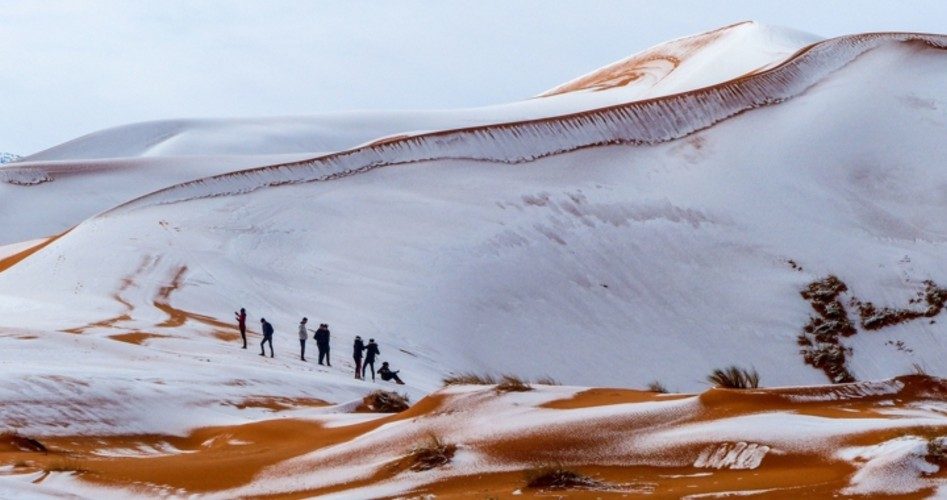
It’s winter and this time of year, it snows. There are places in the world where we expect to see a lot of snow. The Alps, the Himalayas, the Sahara Desert, and Buffalo, New York. Wait — what was that third one again?
No, the Sahara Desert is not a place where we expect to see snow. But Ain Sefra, Algeria, the so-called gateway to the desert, recently experienced a large snowfall, covering the red desert dunes with up to 18 inches of snow. It also snowed a tiny amount last winter in Ain Sefra — the first snowfall in nearly four decades.
The pictures of the snow are quite striking by the way. Some of them can be seen here.
As of yet, no camels have been sighted stranded on ice floes. Also, the snow seems to have come too late for Algeria to field a competitive winter Olympic squad for this year’s games in South Korea.
The bizarre weather comes on the heels of last week’s “bomb cyclone,” which battered the northeastern United States with snow and Arctic temperatures. In fact, according to meteorologists, the same weather system that caused the bomb cyclone was pulled south to North Africa over the past weekend, due to high pressure over Europe.
As of Tuesday, no major climate alarmist has blamed the Saharan snowstorm on global warming. But last week, Penn State climatologist Michael Mann did blame the same weather system that seems to have caused the odd weather in the Sahara on climate change, calling it “an example of precisely the sort of extreme winter weather we expect because of climate change.”
Dr. Roy Spencer, a meteorologist and principal research scientist at the University of Alabama in Huntsville, disagrees with Mann. He put it this way in a blog post on January 7: “To attribute every winter cold wave or heat wave to global warming is just plain silly.”
Ironically, the desert blizzard came just scant days after a new study by the journal Nature Climate Change suggested that the entire Earth will begin to become a desert by the year 2050. “Our research predicts that aridification would emerge over about 20-30 percent of the world’s land surface by the time the global mean temperature reaches 2 degrees Celsius,” said the lead researcher of the study, Manoj Joshi of the University of East Anglia (yes, the same University of East Anglia involved in the “Climategate” scandal). The study cites meeting the goals set forth in the Paris Climate Accord as a key factor in ensuring that the rest of the world doesn’t become like the Sahara — and, no, I don’t mean snow-covered.
So, global warming is set to cause desertification of a large swath of Earth by 2050 but, until then, we can expect an increase in atmospheric moisture (due to global warming) to cause more and larger hurricanes and bomb cyclones such as the ones experienced in the United States during the last six months? Wouldn’t the increased atmospheric moisture cancel out the desertification, or vice-versa?
Climate alarmists are constantly telling us that weather is not the same as climate, and they’re absolutely right. Weather from day to day can be very hard to predict. Climate from decade to decade and eon to eon is much harder to predict. While alarmists continually mock even the slightest notion of skepticism about climate change, they continually wrongly predict the consequences of global warming. Carbon credit entrepreneur Al Gore told us with a straight face that there would be no more Arctic sea ice in the summer months by 2013. He was spectacularly wrong, yet he is never called out for it. When such predictions don’t come true, there is never an apology; just more Chicken-Little proclamations such as the desertification study by Nature Climate Change.
We’ve heard all this before. In 2014, France’s foreign minister Laurent Fabius said, “we have 500 days to avoid climate chaos.” In 2009, British Prime Minister Gordon Brown claimed that there were only 50 days to save the world from global warming.” In 2007, the former head of the Intergovernmental Panel on Climate Change, Rajenda Pachauri, said, “If there’s no action before 2012, that’s too late.”
According to all these predictions, it’s already too late to save the species. Maybe it’s time to leave us all alone and let us live out our remaining years in peace.
Of course, one anomalous weather event — be it snow in the Sahara or a hurricane in Houston — does not prove or disprove anything. The best data show that, from the 1880s to the present day, the global mean temperature has legitimately risen by approximately 1.5 degrees Fahrenheit. However, the debate on whether that slight rise over the last 130-some odd years is man-made is not “over” as the world’s foremost pseudo-climatologist, Al Gore, claims.
Photo of snow near Ain Sefra, Algeria: AP Images



